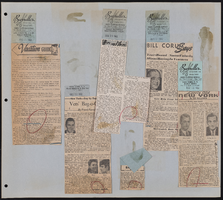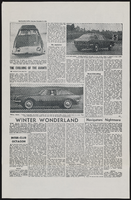Search the Special Collections and Archives Portal
Search Results
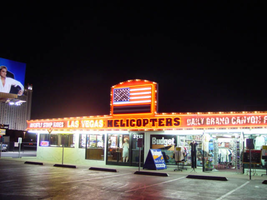
Photographs of Las Vegas Helicopter Tours signs, Las Vegas (Nev.), 2002
Date
Archival Collection
Description
Site address: 3712 S Las Vegas Blvd
Sign details: The establishment rests in a lot on the western side of the strip adjacent to the airfield, which is utilized for takeoff and landing of the aircraft. The Las Vegas Helicopter facility is also adjacent to and shares a building with a souvenir shop.
Sign condition: Structure 5 Surface 5 Lighting 5
Sign form: Fascia
Sign-specific description: The Las Vegas Helicopter tours facility possesses a quite elaborate wall sign which wraps the fascia of the building. The face of the building looks east. The eastern face is an entablature bordered in with polished gold aluminum raceway lined with incandescent bulbs. In the center of the eastern face of the narrow border transforms into a rectangular face, which juts upward. A giant pan channel representing the American flag occupies the space in the section. The horizontal red and white stripes are painted channels, and the blue field in the upper left- hand corner is a channel itself. The horizontal channels are lined with tubes of neon in a corresponding color. The blue field is bordered in blue neon, with incandescent bulbs in the center of graphically painted stars. The entire flag is bordered in red neon. The entablature below which runs along the entire face of the building plays home to several phrases of different text and designs. The center portion is taken up by a phrase "Las Vegas Helicopters," in black channel letters painted red on the interior. The exterior edge is lined with a border of red neon. The text is also filled with incandescent bulbs. To the left of the main title, smaller black, channel letters filled incandescent bulbs read, "Nightly Strip Rides" in all caps. The raceway deviated from the straight form underneath the secondary text, next to the primary title. On the bottom edge beneath the phrase, the raceway turns into an arrow pointing downward. The incandescent bulbs are still present along this deviation.
Sign - type of display: Neon; Incandescent; Backlit
Sign - media: Steel; Glass
Sign - non-neon treatments: Graphics; Paint
Sign animation: Chasing, flashing, oscillating
Notes: The incandescent bulbs inside the text reading "Paris" on the balloon oscillate rapidly.
Sign manufacturer: Sign Systems, Inc
Sign - date of installation: 1996
Sign - thematic influences: There is no real present theme evident in the appearance other than the Emblem of the American flag crafted in neon on the front of the building. The incandescent bulb lined raceways and bulb filled channel letters, placed within a pediment hanging above the pedestrians head, posses a theme in a sense. It is a common occurrence to see such a combination of lighting among the strip to designate an establishment so its theme cold be considered to be that of Las Vegas. It's artistic significance can only be linked to such a trait. It is one of the most unique properties considering its function. Yes there are many facilities which offer tours but, this is the only one which provides helicopter tours that the pedestrian may watch take off. It is also one of the only establishments where the American flag is represented on the exterior in neon. It is also one of the only establishments where the incandescent bulb lined raceway is shaped into arrows. An interesting use of the most common adornment of exterior surveyed signage.
Surveyor: Joshua Cannaday
Survey - date completed: 2002
Sign keywords: Chasing; Flashing; Oscillating; Fascia; Neon; Incandescent; Backlit; Steel; Glass; Graphics; Paint
Mixed Content
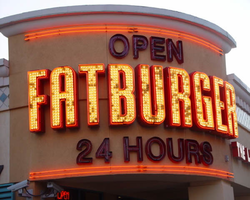
Photographs of Fatburger signs, Las Vegas (Nev.), 2002
Date
Archival Collection
Description
Site address: 3763 S Las Vegas Blvd
Sign details: The Fatburger establishment is directly north across a small drive from Walgreen's. The pylon contains a logo sign, but the most dominant is the text logo above the main entrance. The small parking in front of the building is illuminated with its incandescence. Smaller signs spread out evenly on both the west and south walls.
Sign condition: Structure 5 Surface 5 Lighting 5
Sign form: Pylon; Fascia
Sign-specific description: The Fatburger eatery is directly north from Walgreen's in the same parking lot. It resides on the east side of the strip. The entrance faces SW, mirroring the Walgreen's entrance. It is a rounded storefront design with "Fatburger" spelled in all capital, large, red, channel letters bordered in red neon. The letters face outward and follow the same radius of the entrance, creating a fascia effect with the size of the text. They are filled with incandescent bulbs, which oscillate in a random pattern. Open, red, channel letters, filled with red neon sit above and below the large "Fatburger" text. Above the main sign the letters read "open" and below they read "24 Hours". At the north end of the west face of the building is a diamond shaped, red, steel box with the "Fatburger" in silver channel letters with yellow neon in the interior of the letters. The diamond shape has a border of red neon on its face. Flanking the main entrance, on the south and west face of the building in red steel channel letters, with red translucent plastic faces, the phrase "The last great hamburger stand" is spelled in all caps. They reside approximately the same height on the building as the "24 Hours" script on the main sign. Additional signage is located on the bottom portion of the pylon sign designated for the "The Plaza." Above the back-lit cabinet is an arrangement of text and logo for Fatburger. From left to right, "Fatburger" is spelled in channel letters, the diamond logo is in the center of the sign, then "Fatburger" is spelled again in yellow channel letters. The channel letters are closed front with red translucent plastic. The diamond is outlined in red neon.
Sign - type of display: Neon; Backlit
Sign - media: Steel; Plastic
Sign - non-neon treatments: Graphics; Paint
Sign animation: Flashing, oscillating
Notes: The incandescent bulbs which are present inside the main channel letters, over the main entrance all turn on and hold, oscillate rapidly, then shut off.
Sign environment: The Fatburger eatery is in a unique position, being a widely known property located in a conglomerate of shops including such other well traveled properties such as Walgreen's and McDonald's. In fact, the building is located exactly between these locations. Walgreen's lies directly to the south, with McDonald's to the north. The small stretch of properties is dwarfed by the megalithic MGM further to the north, while the elaborate detail of the New York New York resides west across Las Vegas Blvd Once a pedestrian passes the MGM, headed north, on the east-side of the strip, the Fatburger does makes an lasting impression upon the passerby, being the brightest of the three immediate company.
Sign - thematic influences: Fatburger is another example of a typical everyday establishment turned into an electrifying display to fit in with its environment. No particular theme can be seen specifically other than the logo and color scheme influenced by the establishment itself. The entrance to the establishment contains the text wrapping the radius of the corner, creating a beacon for pedestrians. Such influence can be seen in other larger properties with corner entrances such as the Flamingo, the Barbary Coast, Harrah's, and O'Shea's.
Surveyor: Joshua Cannaday
Survey - date completed: 2002
Sign keywords: Flashing; Oscillating; Pylon; Fascia; Neon; Backlit; Steel; Plastic; Graphics; Paint
Mixed Content
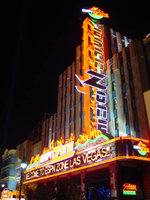
Photographs of ESPN Zone signs, Las Vegas (Nev.), 2002
Date
Archival Collection
Description
Site name: New York-New York Hotel and Casino (Las Vegas, Nev.)
Site address: 3790 S Las Vegas Blvd
Sign details: Located in New York-New York Casino and Hotel
Sign condition: Structure 5 Surface 5 Lighting 5
Sign form: Pylon; Fascia; Porte-cochère
Sign-specific description: The northern end of the property is dominated by the signage for the ESPN Zone sports lounge, located inside the NY NY. The exterior signage is basically a theatre marquee entrance with a long overhang supporting an electronic message banner that reads from left to right. The majority of the theatre front is polished aluminum with thin tubes of red neon above and below the electronic reader board. Above the top edge of the actual front of the sign is a design of pan channels, crafted and shaped to form a complex background for the logo text spelling "ESPN." A wavy green crafted channel creates what looks like a horizon. The space between the marquee and the green channel is a black field laden with incandescent bulbs. Above the green channel an array of pan channels crafted into interlocking, swaying, pointed shapes. They are painted yellow and orange so the result is a bed of flames. These too are lined in the interior of the contour in red and orange neon. In the center of the entire face of the overhand in a black steel cabinet with the logo for the establishment spelling "ESPN Zone." The First portion of the two-word phrase is spelled in shallow channel letters lined with horizontal bars of white neon. The text is outlined in red neon as well. The second half spells "Zone," and is written in the same font with the "Z" being the largest letter in the sign, designed with the bottom horizontal leg underlining the rest of the letters in the word. The word is outlined with white neon as well. The latter portion is filled with horizontal bars of red neon. Situated along the middle of the sign, and against the vertical plane of the building, a blade sign repeats the design and colors of the bottom portion of the sign. The vertical cabinet is double sided spelling the "ESPN Zone" logo vertically with the same neon treatments for the respective words. The three toned background of black, green, red and orange on the bottom of the sign is interpreted on the blade. Running vertically, the black portion laden with bulbs runs against the wall, with the wavy channel next to that, disappearing temporarily behind the letters. The flames hang off of the outer edge of the sign. All of the neon treatments are seen here as well. Crowning the top of the blade sign two circular cabinets are arranged touching each other at one end, the faces pointing out to angled directions. Here the ESPN logo is arranged inside a circle. The bottom half below the letters is filled with horizontal bars of green neon, while the flames are present on the top half. The same cabinets can be seen mounted on the ends of the bottom overhang.
Sign - type of display: Neon; Incandescent; Backlit
Sign - media: Steel; Plastic
Sign - non-neon treatments: Graphics
Sign animation: Notes: The letters in the vertical blade portion of the ESPN Zone illuminate one at a time, starting from the top. Once the entire phrase is lit, in flashes off then on then off, before restating. The orange and red neon tubing which resides inside the pan channels that represent flames flash on and off in a relaxed manner as if to animate the flickering of the flames. The small incandescent bulbs on the black portions above the main matrix reader board flash on and off subtly.
Surveyor: Joshua Cannaday
Survey - date completed: 2002
Sign keywords: Chasing; Flashing; Oscillating; Pylon; Fascia; Porte-cochère; Neon; Incandescent; Backlit; Steel; Plastic; Graphics
Mixed Content
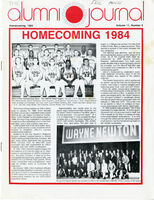
UNLV Alumni Journal, Volume 11, Number 5
Date
Archival Collection
Description
Volume 11, number 5 edition of the University of Nevada, Las Vegas "The Alumni Journal."
Mixed Content
Ford, Jean, 1929-1998
Nevada politician and women's advocate Imogene "Jean" Young was born in Miami, Oklahoma, on December 28, 1929, to Daisy Adelphia (Flook) and Clarence Nathan Young. She had one brother, Byron Young. Her family moved to Joplin, Missouri, where she attended kindergarten through high school. In 1951 she graduated from Southern Methodist University in Dallas, Texas with a B.A. in Sociology. After graduation she worked as a recreational therapist for the American Red Cross in military hospitals until 1955.
Person
George Kelly Ryan Photograph Collection
Identifier
Abstract
The George Kelly Ryan Photograph Collection (1929) depicts waterways in Southern Nevada and Northern Arizona. The collection consists of eight photographic prints and two photographic negatives depicting Saint Thomas, Black Canyon, Boulder Canyon, and the Colorado River.
Archival Collection
State of Arizona vs. State of California Proceedings Concerning the Colorado River Usage Dispute
Identifier
Abstract
The State of Arizona vs. State of California Proceedings Concerning the Colorado River Usage Dispute collection (1957-1961) contains supplemental documents from the
Archival Collection
George Kelly Ryan Papers
Identifier
Abstract
The George Kelly Ryan papers (1921-1971) contain correspondence inquiring about Octavius Decatur "O. D." Gass, newspaper clippings from 1929, handwritten recollections of the Gold Ranch by Laura Royce, and a San Pedro, Los Angeles and Salt Lake Railroad Company information, including information on wash-outs in Nevada.
Archival Collection

